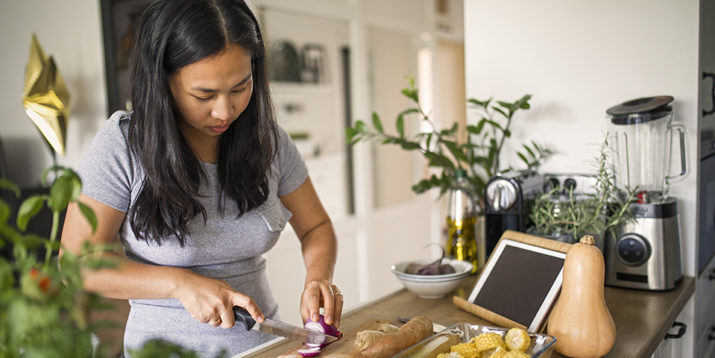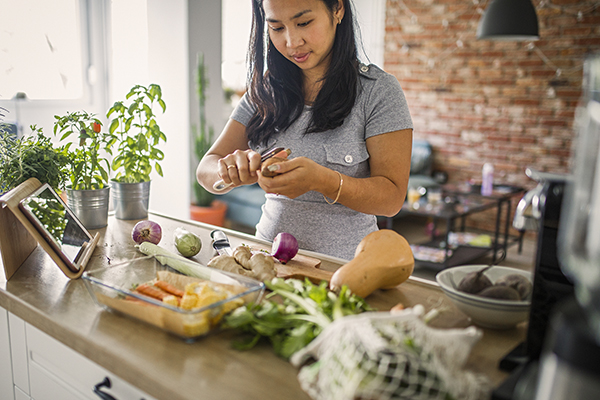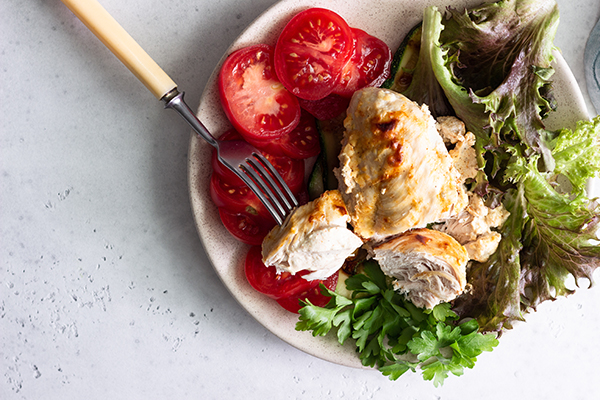Air Fryer vs. Instant Pot: Which Is the Better Choice for You?

Smart kitchen tools can feel like a godsend. They make cooking faster, easier, and less stressful, and they can also make your favorite meals healthier.
Air fryers and Instant Pots are two kitchen gadgets in particular that can transform meals and make meal prepping as easy as hitting a button.
But do you need both? For all your air fryer vs. Instant Pot questions, we’ve got you covered!
Air Fryer vs. Instant Pot: What Can You Cook?
Let’s start with the basics: What the heck is an Instant Pot — and how does an air fryer work?
An Instant Pot is an electric pressure cooker and “multicooker,” while an air fryer is a countertop convection over that essentially “fries” your food with super hot air and a little (optional) oil.
You can use both the air fryer and the Instant Pot to prep some of the same foods, but generally speaking, “air fryers are better used for foods you want to crisp or dry out, like healthier versions of French fries, ‘fried’ chicken, or apple crisps,” says Krista Maguire, RD, CSSD, Nutrition Manager at Beachbody.
“An Instant Pot is best used for dishes with liquid, like soups and stews, chili, grains, casseroles, and one-pot dishes,” she explains.
Here are some examples of foods that are best used in each:
| Food | Air Fryer | Instant Pot |
| Whole chicken | X | |
| Fries | X | |
| Eggs | X | |
| Soups | X | |
| Stews | X | |
| Vegetables | X | X |
| Rice | X | |
| Empanadas | X | |
| Fish | X | X |
| Yogurt | X | |
| Oatmeal | X | |
| Chili | X | |
| “Fried” chicken | X |

Air Fryer vs. Instant Pot: Which Is Healthier?
It all depends on what you’re cooking and the ingredients you put inside of them.
“Say you’re cooking a cheesy bacon casserole in the Instant Pot and chicken or chickpeas in the air fryer,” says Maguire. “Then the air fryer would win this challenge. On the other hand, if the bacon is going in the air fryer and you’re making a veggie soup in the Instant Pot, then the healthy meter goes in the other direction.”
Instant Pot vs. Air Fryer: Functionality & Price
Instant Pots and air fryers vary in price, depending on the model and amount of features. Ask yourself: What will I cook?
Am I feeding a family of five, or just cooking for myself? Do I make complicated dishes or just want to air fry some chicken wings here and there?
Depending on the intended use, you can make an informed decision on budget and functionality needs.
The Instant Pot Ultra, for example, is on the higher end at around $150 but does the work of 10 different appliances in one.
For more budget-minded consumers, this Instant Pot 6-in-1 is half the price yet straightforward and durable.
This Air Fryer from Philips has fat removal technology (it collects in the bottom) and tons of space but will cost you almost $300. However, you can easily find smaller, simpler air fryers for under $100, like this one.
Again, it all comes down to intended use and personal budget.

Instant Pot Pros & Cons
Pros:
- They’re more versatile. “It’s a pressure cooker, slow cooker, [and] rice cooker,” says Sofia Norton, RD.
- Saves time and headspace. Instant Pots are great for “setting it and forgetting it.”
- Convenient for making big batches or feeding a large family.
- You can cook meat from its frozen state. No thawing necessary!
- Automatically keeps your food warm after it’s done cooking.
Cons:
- Bulky. Instant Pots can take up valuable counter space.
- Can be difficult to clean.
- Not as “instant” as you might think. It takes a while to come to full pressure/heat to cook your food.
- Some versions are pretty costly.
- “Learning to cook with it involves some trial and error,” says Norton.
- If you don’t follow the directions, you can overcook your food.
Air Fryer Pros & Cons
Pros:
- Works quickly and is energy efficient.
- Makes fried foods like fried chicken and French fries healthier.
- Many models are small and compact.
- Simple to use and easy to clean.
- Some models have pre-programmed settings for different foods.
Cons:
- Foods can easily dry out if not used properly.
- Not ideal for bulk cooking since they’re pretty compact.
- Not as versatile as an Instant Pot.
- Some models are bulky and take up lots of kitchen space.
- Basket shape can be awkward. Some models are too small for foods that don’t bend easily (like taquitos or chicken wings).
